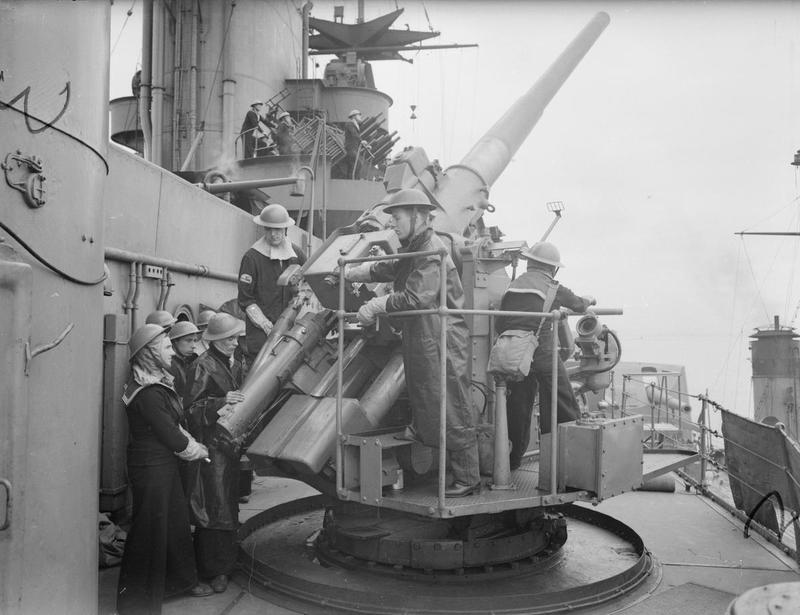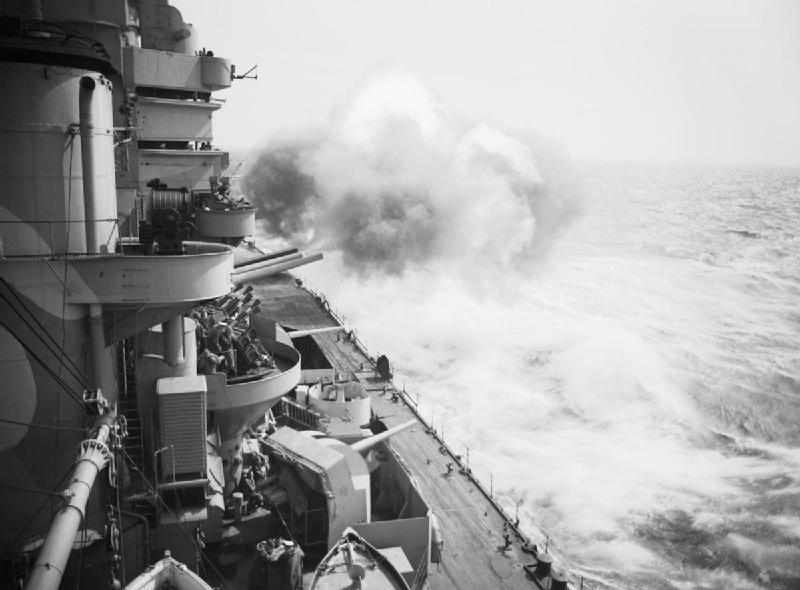
The 4.7"/43 (12 cm) Mark VII was a fixed-ammunition AAA gun developed late in World War I. Only four guns were made and these did not enter service. Performance was said to be similar to that of the later 4.7"/40 (12 cm) QF Mark VIII. It had been planned to fit the "A" class Flotilla Leader HMS Codrington with these guns, but this was cancelled and she commissioned with an outfit of 4.7"/45 (12.7 cm) Mark IX guns.
The 4.7"/40 (12 cm) QF Mark VIII was originally developed as an AAA weapon for the "G3" and "N3" capital ships of 1920. When those ships were cancelled as a result of the Washington Naval Limitation Treaty, these weapons were then mounted on the Nelson class battleships and on converted carriers. This was the largest caliber fixed-ammunition gun ever to enter service in the Royal Navy, although the rounds for these guns were lighter and shorter than the fixed rounds developed for the later 4.5"/45 (11 cm) guns.
The fixed round for this weapon weighed a total of 74 lbs. (33.6 kg). During service evaluation, it was found that this weapon could not maintain a high rate of fire - a necessity for an AA weapon - as the heavy round rapidly wore out the gun crews.
The Mark VII was constructed of a tapered inner A tube, A tube, full length wire, jacket and breech ring. Used a horizontal sliding breech mechanism that opened automatically after firing.
The Mark VIII was constructed of a tapered inner A tube, A tube, part length wire, jacket and breech ring. Used a horizontal sliding breech mechanism. Guns could be operated in either Quick Firing (QF) or Semi-Automatic (SA) mode. In QF mode, the breech was manually opened after firing by moving a lever which also ejected the spent casing. In SA mode, the breech would open automatically after firing and eject the spent casing. During loading, the breech mechanism would partially close when the cartridge case rim hit the ejectors and then fully close when the loading tray was raised.
The mountings were unusual for British guns in having a power rammer, which allowed faster firing at high elevations. The rammer was carried by the loading tray rocking arm. Rounds were laid in a loading tray which then was manually pushed over before the rammer could be operated and the breech closed. Springs were used for runout. A total of 84 guns were made.
The 4.7"/40 (12 cm) Mark X was a separate ammunition version of the 4.7" (12 cm) Mark VIII. Only one of these guns was ever built and it was used for a few years on the submarine HMS Perseus in a 50 degree CPXV mounting.
All British 4.7" guns have an actual bore diameter of 4.724" (12 cm).
The data that follows is specifically for the Mark VIII except where noted.
| Designation | 4.7"/43 (12 cm) QF Mark VII
4.7"/40 (12 cm) QF Mark VIII 1 4.7"/40 (12 cm) QF Mark X |
|---|---|
| Ship Class Used On | Mark VII: N/A
Mark VIII:Nelson, Courageous, Albatross and Adventure classes Mark X: Submarine Perseus |
| Date Of Design | Mark VII: about 1918
Mark VIII: 1925 Mark X: about 1930 (?) |
| Date In Service | Mark VII: Not in service
Mark VIII: 1926 Mark X: about 1931 (?) |
| Gun Weight | Mark VII: 7,560 lbs. (3,429 kg)
Mark VIII: 6,636 lbs. (3,010 kg) Mark X: N/A |
| Gun Length oa | 197 in (5.004 m) |
| Bore Length | 189 in (4.800 m) |
| Rifling Length | 161.7 in (4.108 m) |
| Grooves | (38) 0.037 in deep x 0.270 (0.94 x 6.86 mm) |
| Lands | 0.1205 in (3.061 mm) |
| Twist | Uniform RH 1 in 30 |
| Chamber Volume | Mark VII: 475 in3 (7.78 dm3)
Mark VIII: 454 in3 (7.44 dm3) Mark X: N/A |
| Rate Of Fire | 8 - 12 rounds per minute 2 |
- ^Prefixes E and F, referring to direct electric (DEF) and electrical mechanical (EMF) firing are sometimes found in gun lists.
- ^The fastest practical firing cycle was about 5 seconds. Faster cycle times were recorded with 15 rounds per minute being the highest, but the rammers became unreliable at these speeds.
| Type | Fixed |
|---|---|
| Weight of Complete Round | HE: 76 lbs. (34.5 kg) 1a 2a SAP: 76 lbs. (34.5 kg) Illum: N/A Smoke: N/A |
| Projectile Types and Weights | HE: 50 lbs. (22.68 kg)
SAP: N/A Illum: N/A Smoke: N/A |
| Bursting Charge | N/A |
| Projectile Length | N/A - complete round 44.26 in (11.24 cm) |
| Propellant Charge 1a | 9.34 lbs. (4.24 kg) MC19
10.19 lbs. (4.63 kg) SC103 10.94 lbs. (4.96 kg) NF/S 164-048 Cartridge 26 lbs. (11.82 kg) |
| Muzzle Velocity | 2,457 fps (749 mps) |
| Working Pressure | 20.5 tons/in2 (3,230 kg/cm2) |
| Approximate Barrel Life | 1,050 - 1,200 rounds |
| Ammunition stowage per gun 3a | Nelson class: 175 rounds
Courageous class: 270 rounds Others: 100 rounds |
- ^In 1931 it was estimated that the lethal radius of the HE shell against aircraft had a volume 33 feet long by 78 feet in diameter (10 x 24 m). This was probably too optimistic and post-war analysis of other AAA guns greatly reduced their pre-war estimated lethal radius.
- ^Outfits for smaller ships included SAP and HE but the Nelson class did not carry SAP. Outfit for Nelson class was 175 HE per gun plus 150 Star Shell and 20 target smoke rounds per ship. Star Shell allowance was upped to 400 rounds during World War II.
| Elevation | Distance |
|---|---|
| 45 degrees | 16,160 yards (14,780 m) |
| AA Ceiling | 32,000 feet (9,750 m) |
| Designation | Open Single Mounting
Codrington (1): HA Mark XI Nelson (6) 1b, Courageous (16) and Albatross (4): HA Mark XII Perseus (1) 2b: CPXV |
|---|---|
| Weight | 27,692 lbs. (12,561 kg) |
| Elevation | HA Mark XII: -5 / +90 degrees 3b CPXV: -5 (?) / +50 degrees |
| Elevation Rate 4b | HA Mark XII: 10 degrees per second
CPXV: Manually worked, only |
| Train | 360 degrees |
| Train Rate 4b | 10 degrees per second
CPXV: Manually worked, only |
| Gun recoil | 18 in (46 cm) |
- ^Some mountings had simple shields added and an armored "zareba" was fitted around the 4.7" (12 cm) gun decks on Nelson and Rodney in 1940.
- ^Perseus was later fitted with the standard 4"/40 (10.2 cm) submarine gun.
- ^HMS Rodney had one mounting with rack type rammer gear, which limited elevation to 77 degrees.
- Each HA mounting had a fuze setter on the left side.




"Nelson to Vanguard: Warship Design and Development 1923-1945" by D.K. Brown
"Naval Weapons of World War Two" and "British Naval Guns 1880-1945 No 15" article in "Warship Volume IX" both by John Campbell
"British Carrier Aviation" by Norman Friedman
"British Battleships of World War Two" by Alan Raven and John Roberts
"Destroyers of World War Two" by M.J. Whitley
31 December 2006 - Benchmark
12 February 2012 - Updated to latest template
15 December 2013 - Added photograph of Rodney amidships
30 August 2014 - Added photograph of guncrew and notes about number guns built and about the fuze setter
06 November 2015 - Added photograph of deck scrubbing
31 August 2019 - Converted to HTML 5 format, reorganized notes, added comments about breech mechanism in QF and SA modes
17 June 2020 - Corrected formatting problem
